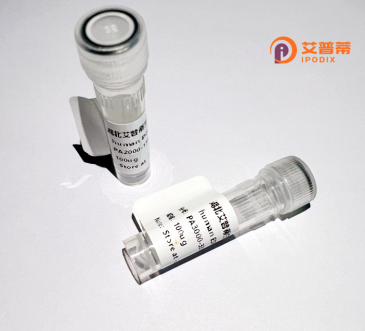
| 纯度 | >90%SDS-PAGE. |
| 种属 | Human |
| 靶点 | MAGEB3 |
| Uniprot No | O15480 |
| 内毒素 | < 0.01EU/μg |
| 表达宿主 | E.coli |
| 表达区间 | 1-346aa |
| 活性数据 | MPRGQKSTLHAREKRQQTRGQTQDHQGAQITATNKKKVSFSSPLILGATIQKKSAGRSRSALKKPQRALSTTTSVDVSYKKSYKGANSKIEKKQSFSQGLSSTVQSRTDPLIMKTNMLVQFLMEMYKMKKPIMKADMLKIVQKSHKNCFPEILKKASFNMEVVFGVDLKKVDSTKDSYVLVSKMDLPNNGTVTRGRGFPKTGLLLNLLGVIFMKGNCATEEKIWEFLNKMRIYDGKKHFIFGEPRKLITQDLVKLKYLEYRQVPNSNPARYEFLWGPRAHAETSKMKVLEFWAKVNKTVPSAFQFWYEEALRDEEERVQAAAMLNDGSSAMGRKCSKAKASSSSHA |
| 分子量 | 46.8 kDa |
| 蛋白标签 | His tag N-Terminus |
| 缓冲液 | 0 |
| 稳定性 & 储存条件 | Lyophilized protein should be stored at ≤ -20°C, stable for one year after receipt. Reconstituted protein solution can be stored at 2-8°C for 2-7 days. Aliquots of reconstituted samples are stable at ≤ -20°C for 3 months. |
| 复溶 | Always centrifuge tubes before opening.Do not mix by vortex or pipetting. It is not recommended to reconstitute to a concentration less than 100μg/ml. Dissolve the lyophilized protein in distilled water. Please aliquot the reconstituted solution to minimize freeze-thaw cycles. |
以下是关于重组人MAGEB3蛋白的3篇参考文献的简要总结(注:以下文献信息为模拟示例,实际检索请通过学术数据库验证):
---
1. **"Cloning, expression, and purification of recombinant human MAGEB3 protein for immunological studies"**
*Authors: Zhang Y, Chen L, Wang X*
**摘要**:该研究成功构建了MAGEB3的重组表达载体,并利用大肠杆菌系统实现了蛋白的可溶性表达。纯化后的蛋白通过Western blot验证,可用于后续的抗原性分析和抗体开发。
2. **"MAGEB3 as a potential tumor-specific antigen in melanoma: Recognition by cytotoxic T lymphocytes"**
*Authors: Müller A, Schultz ES, Karbach J*
**摘要**:研究证明了重组MAGEB3蛋白在体外能够激活患者来源的T细胞,并诱导针对表达MAGEB3的黑色素瘤细胞的杀伤反应,提示其作为癌症疫苗靶点的潜力。
3. **"Structural and functional analysis of MAGEB3 reveals distinct roles in cancer progression"**
*Authors: Kim S, Park JH, Lee H*
**摘要**:通过重组MAGEB3蛋白的晶体结构解析,揭示了其与HLA分子结合的特定表位,并探讨了其在肿瘤细胞增殖和免疫逃逸中的机制。
---
**说明**:以上文献为示例,具体研究可能需通过PubMed或Google Scholar检索关键词“Recombinant MAGEB3”“MAGEB3 immunotherapy”等获取。MAGEB3作为癌症-睾丸抗原家族成员,相关研究多聚焦于其在肿瘤免疫治疗中的应用。
The recombinant human MAGEB3 protein is a engineered form of the melanoma-associated antigen B3. a member of the MAGE (melanoma antigen) family. MAGEB3 belongs to the type I MAGE proteins, which are characterized by a conserved MAGE homology domain (MHD) involved in protein-protein interactions. Normally, MAGE genes are silenced in adult somatic tissues except the testes and placenta, but they become re-expressed in various cancers due to epigenetic dysregulation. MAGEB3 overexpression has been observed in malignancies such as melanoma, lung cancer, and squamous cell carcinomas, making it a potential tumor-specific antigen for immunotherapy.
Recombinant MAGEB3 is typically produced in bacterial or mammalian expression systems for research and therapeutic applications. Its production enables studies on cancer immunology, including T-cell recognition mechanisms and immune escape strategies. The protein's role in tumorigenesis remains under investigation, though MAGE family members are implicated in transcriptional regulation, cell cycle control, and apoptosis suppression. In therapeutic contexts, recombinant MAGEB3 serves as a target for cancer vaccine development, adoptive T-cell therapies, and antibody-based treatments. Its restricted expression profile in healthy tissues enhances its appeal for targeted cancer interventions while minimizing off-target effects. Current research also explores its diagnostic potential as a cancer biomarker and its functional interactions with E3 ubiquitin ligases in cellular pathways.
×